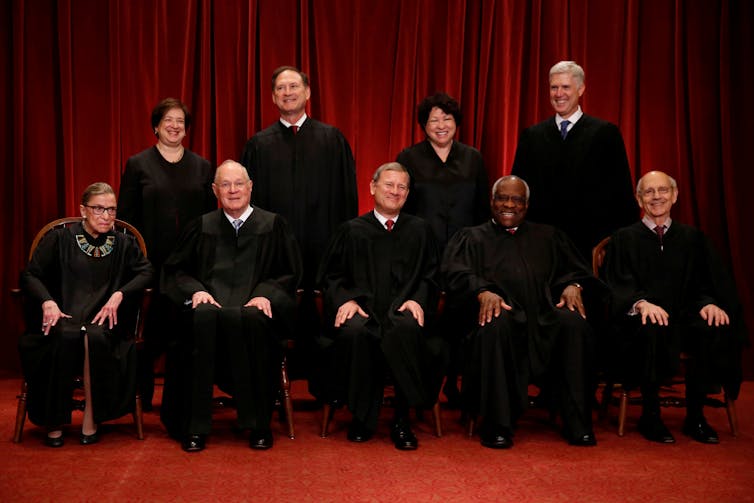Supreme Court polarization is not inevitable — just look at Europe
- Written by David Orentlicher, Professor of Law and Co-Director, Health Law Program, University of Nevada, Las Vegas
United States President Donald Trump has nominated Brett Kavanaugh[1] to replace retiring Supreme Court Justice Anthony Kennedy. His choice solidifies a conservative majority on the nation’s nine-member highest court.
Trump’s conservative bench could overrule Roe v. Wade[2], eliminating women’s constitutional right to abortion. It also could condone political gerrymandering and put LGBTQ people at further risk for discrimination[3] by employers, landlords and business owners.
A politically polarizing court is not inevitable. In some European countries, the judicial appointment process is actually designed to ensure the court’s ideological balance[4], and justices work together to render consensus-based decisions.
Europe’s centrist constitutional courts
I am a scholar[5] of high courts worldwide, which are typically called “constitutional courts.”
Europe’s constitutional courts differ[6] from country to country, but they have some important similarities. They generally decide only constitutional questions posed by the legislature or by lower courts, rather than cases brought by individuals.
Oral arguments are rare, and the justices deliberate in private, considering written arguments. The courts generally have more members than the U.S. Supreme Court – 12 to 20 judges[7] – but they also often operate in smaller panels.
Judicial appointments in such systems rarely provoke the kind of partisan confirmation battle that is likely to play out now in Washington[8].
 Judge Brett Kavanaugh.
U.S. Court of Appeals for the District of Columbia Circuit via Wikimedia Commons[9]
Judge Brett Kavanaugh.
U.S. Court of Appeals for the District of Columbia Circuit via Wikimedia Commons[9]
That’s because many European countries ensure that all sides of the political spectrum[10] have a say in choosing constitutional court judges.
In Germany, for example, the legislature conducts the appointment process in a bipartisan fashion[11]. The political parties negotiate over the nominees, identifying candidates who are acceptable to both the left and right.
Because each justice must be approved by a two-thirds vote, all candidates need to appeal to lawmakers from across the political spectrum.
Spain and Portugal likewise require a legislative supermajority to approve constitutional court nominees[12].
In the U.S.[13], by contrast, the president picks a Supreme Court nominee – in this case, Judge Kavanaugh, a conservative mainstay[14] on the D.C. Circuit Court of Appeals. He must now be confirmed by a simple majority – 50 percent, plus one vote – in the Senate.
How compromise works
Many European courts also take a more centrist approach to issuing rulings.
Rather than deciding cases by majority vote, as the U.S. Supreme Court does, constitutional courts in Europe often operate on consensus. German and Spanish justices rarely write dissenting opinions[15] to express their disapproval of a court ruling. Dissents do not exist[16] in Belgium, France and Italy.
When all justices have to agree, compromise is essential.
The U.S. Supreme Court itself recently demonstrated this. More than a year elapsed[17] between the death of Justice Antonin Scalia in 2016 and the appointment of Justice Neil Gorsuch in 2017. During that time the court was evenly split[18] between liberals and conservatives, four to four.
The eight justices worked harder to find common ground[19] on divisive issues. When asked to decide whether religiously oriented employers must provide health coverage that covers contraception[20], they fashioned a compromise: Insurance companies would be required to provide coverage to employees without the employers having to take any action to ensure that the coverage was provided.
 The Supreme Court’s nine justices, as of July 9, 2018.
Reuters/Jonathan Ernst
The Supreme Court’s nine justices, as of July 9, 2018.
Reuters/Jonathan Ernst
People tend to like centrist courts
Somewhere between two-thirds and three-quarters of Germans express confidence[21] in their highest court, and approval is strong from both the left and right.
In contrast, public approval of the U.S. Supreme Court has been steadily declining for years[22]. A majority of Americans once expressed strong confidence in the court. Today, a Gallup poll finds, only 37 percent do[23].
While public approval has historically tended to be similar for Democratic and Republican voters, the past two decades have seen increasing polarization[24]. Currently, 44 percent of Republicans have a great deal of confidence in the court. Just 33 percent of Democrats do.
If Kavanaugh is confirmed by the Senate, the court will likely swing decidedly to the right, further polarizing Americans.
Conservative Americans can feel confident that their interests on abortion, civil rights and the role of religion in society are well reflected on the Supreme Court. Liberal and moderate Americans – who make up about 60 percent[25] of the U.S. population – cannot.
A one-sided court majority also increases the risk of ill-advised legal decisions. Numerous studies on decision-making find[26] that groups make better decisions when they take into account a diversity of perspectives.
Can the US depoliticize its courts?
The Senate and the Supreme Court could agree to do things differently in the United States.
Consensus-based judicial decision-making is only required by law[27] in some European countries. Many European constitutional courts have simply imposed this norm[28] upon themselves and developed policies to ensure consensus is reached.
The U.S. Supreme Court itself even observed a norm of consensual decision-making[29] for most of its history. Until 1941, the justices typically spoke unanimously. Only about 8 percent of cases included a dissenting opinion. Now, one or more justices dissent in about 60 percent of rulings[30].
Chief Justice John Roberts has pushed[31] for greater consensus on the court, saying that the court functions best[32] “when it can deliver one clear and focused opinion.”
With Justice Kennedy’s retirement, Justice Roberts will sit at the ideological middle[33] of the court. He could use that position to forge judicial consensus.
Going forward, the Senate could also insist on more centrist appointments. For example, it could refuse to confirm[34] the president’s nominees if they do not appear on a list already approved by a special bipartisan Senate committee.
Political polarization in the United States has led to highly partisan battles over Supreme Court justices, jeopardizing the credibility country’s celebrated highest court. European countries have figured out how to minimize partisan conflict in their judicial systems.
The U.S. would do well to follow that example.
References
- ^ nominated Brett Kavanaugh (www.nytimes.com)
- ^ overrule Roe v. Wade (fivethirtyeight.com)
- ^ LGBTQ people at further risk for discrimination (www.cnbc.com)
- ^ ensure the court’s ideological balance (papers.ssrn.com)
- ^ scholar (scholar.google.com)
- ^ differ (www.researchgate.net)
- ^ 12 to 20 judges (papers.ssrn.com)
- ^ likely to play out now in Washington (www.washingtonpost.com)
- ^ U.S. Court of Appeals for the District of Columbia Circuit via Wikimedia Commons (upload.wikimedia.org)
- ^ all sides of the political spectrum (www.researchgate.net)
- ^ bipartisan fashion (papers.ssrn.com)
- ^ supermajority to approve constitutional court nominees (www.researchgate.net)
- ^ In the U.S. (judicialnominations.org)
- ^ conservative mainstay (www.vox.com)
- ^ rarely write dissenting opinions (www.europarl.europa.eu)
- ^ do not exist (www.europarl.europa.eu)
- ^ More than a year elapsed (www.latimes.com)
- ^ evenly split (www.latimes.com)
- ^ common ground (host.madison.com)
- ^ health coverage that covers contraception (www.supremecourt.gov)
- ^ express confidence (www.faz.net)
- ^ steadily declining for years (news.gallup.com)
- ^ only 37 percent do (news.gallup.com)
- ^ polarization (news.gallup.com)
- ^ 60 percent (news.gallup.com)
- ^ studies on decision-making find (papers.ssrn.com)
- ^ only required by law (www.europarl.europa.eu)
- ^ imposed this norm (www.europarl.europa.eu)
- ^ norm of consensual decision-making (scholarship.law.cornell.edu)
- ^ rulings (scholarship.law.cornell.edu)
- ^ pushed (www.nytimes.com)
- ^ best (www.huffingtonpost.com)
- ^ middle (www.vox.com)
- ^ confirm (www.law.cornell.edu)
Authors: David Orentlicher, Professor of Law and Co-Director, Health Law Program, University of Nevada, Las Vegas
Read more http://theconversation.com/supreme-court-polarization-is-not-inevitable-just-look-at-europe-99356

